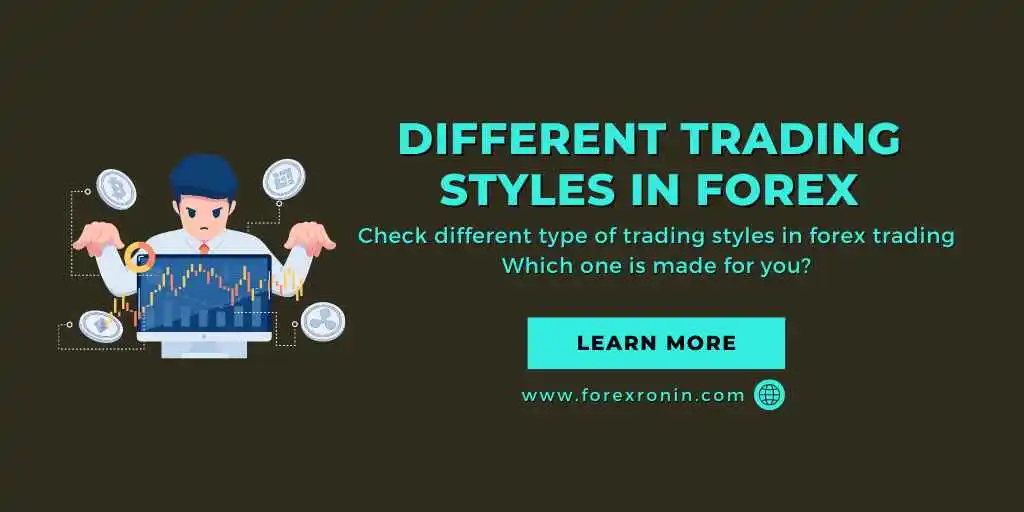There are several different trading styles in forex that a trader can use. These styles include Swing trading, Day trading, and High-frequency trading styles. Each has its own advantages and disadvantages, and some trading styles are better suited for certain kinds of investors.
Below are some of the main trading styles in forex trading.

Position trading
The term “position trading” describes a trading style where investors purchase investments with the intent of holding them for a long period of time. This style is the opposite of day trading, which seeks to capitalize on short-term market fluctuations. Position traders hold their investments for several weeks or months and must identify the correct entry and exit prices. They should also have a strategy that limits their risk.
Position traders are disciplined and patient, which is important for a successful trading style in forex trading. Without discipline, traders can make mistakes and turn small losses into bigger ones. They must also control their emotions when entering and exiting trades. One type of position trading strategy is called a carry trade. This strategy exploits the differences between interest rates in different countries. It involves selling a currency at a low-interest rate and buying another currency at a higher interest rate. Generally, carry traders look for opportunities to profit from this difference in interest rates.

A position trader will often use fundamental analysis and technical analysis to determine the strength of a trend. They try to enter markets with precision and hope to profit from large movements. Fundamental analysis is essential for position traders, as it involves considering fundamental factors such as economic strength, earnings, dividends, and cross-border transactions.
Swing trading : Trading Styles in Forex
Swing trading involves identifying a break in the trend. This occurs when a recent high or low fails to break through the previous high or low. It is important to recognize this trend break before entering or exiting a trade. It is also important to maintain discipline when entering or exiting a trade. Swing traders usually enter buy trades when the price bounces off a support or resistance level.

Using charts can help identify the trend. For example, if an asset is trending lower, place a sell order only when it hits the top line of the channel. For longer-term trends, a trader can also use moving averages to identify the trend. This method allows the trader to make more informed decisions than if he is relying on his gut instinct alone.
There are many trading styles and indicators available for technical analysis. However, no single indicator or strategy is ideal or better than another. Most swing traders develop their own methods over time, after being exposed to several different tools. One such indicator is the RSI, which shows whether a market is overbought or oversold.
Swing trading is an excellent strategy if you want to earn a steady income through short-term price swings. It requires less time and can be a great way to supplement a full-time job. You can also trade as a side job. Swing trading can be a great choice for anyone who is new to the market.
In simple words, if you are looking forward to this among other trading styles in forex, this might require lesser screen time for analyses and stuff but more focusing on the accuracy.
Price Action Trading
Price action trading is a type of trading that relies on technical analysis to make decisions. This means that traders look at price charts to make predictions about where prices are going. Price action trading can be used to trade a variety of assets, including stocks, futures, and currencies.

The Price Action can be considered among some of the most loved among trading styles in forex trading, and this basically depends on one important factor that is, more number of opportunities in the market on daily basis, which is comparatively low if we consider other trading styles in forex. Well, most of the traders that you come along the way will consist of Price action traders and no doubt that it is one of the most important and founding pillars in trading forex, stocks, cryptocurrencies, etc.
Intraday trading : Most Loved Style of Forex Trading
In the world of intraday trading, there are several strategies that you can employ. Some of these techniques involve using technical analysis, while others are based on trading styles. Using technical analysis helps you determine a trend and make better trading decisions. You should also pay attention to events affecting a stock’s price, such as mergers and acquisitions. In addition, you should keep an eye out for dividend payments, stock splits, and bonus issues.
One of the most common intraday trading strategies involves trading at ‘gaps’ in the stock market. Gaps can be caused by news announcements, earnings reports, or a change in a trading strategy. Gaps are often unnoticed by the general public, so traders take advantage of them to make a profit. In addition, you should also keep in mind that you should make decisions quickly and based on current information.
While there are advantages to each of these trading styles, there are some key differences between them. Traders who choose to use intraday trading tend to profit more than other types of trading. They don’t lock in their money for extended periods of time, which allows them to trade more frequently. Moreover, they don’t have to hold positions overnight, which means less risk for them. And, since they’re using their profits sooner, earnings compound more quicker.
When choosing a trading style, be sure to consider the amount of time and money that you’re willing to spend on research. The longer you plan on holding your positions, the more likely you are to lose. The longer you hold them open, the more vulnerable you’ll be to systemic risk, and the lower your chances are of earning a profit.
High-frequency trading : Don’t get confused among these trading styles in forex
High-frequency trading involves placing trades at very fast speeds in an effort to maximize profits. This kind of trading makes use of computer programs that process enormous volumes of information in a short amount of time. The technology also allows these traders to trade on different exchanges at once, taking advantage of the difference in prices. For example, a high-frequency trader may buy AAPL stock on one exchange, and then sell it on another, creating a small profit on the difference in prices.

Although the practice of high-frequency trading has several drawbacks, most HFT methods are legal. High-frequency firms make money from momentum trading, which causes a sudden spike in the price of a stock. The trader can profit from this spike by taking a position early and selling before it fizzles.
Another drawback to high-frequency trading is the fact that HFT is very expensive. These traders face huge competition and have high operating costs. They also compete with long-term investors, which means that they have fewer profit margins. High-frequency firms make up for their low margins by executing large volumes. As a result, these traders have to deal with many risks. This means avoiding mistakes that could cost the company a lot of money.
High-frequency trading involves large capital, massive computing power, and PhD-level programmers. These sophisticated systems are used by hedge funds and specialist investment funds to place orders and monitor prices. These sophisticated algorithms allow high-frequency traders to identify emerging trends in milliseconds. This kind of trading can be risky and involves illegal practices.
News trading: Most Dangerous among other trading styles in forex
Traders who trade news often have a particular method of evaluating news releases, or they have a certain trading style. For example, intraday trading requires a quick analysis of news releases and market reactions. They need to know what to expect from a news release and what to look for in key support and resistance levels. They must also know how to manage their currency positions, often placing stop-loss and take-profit orders to protect their positions.
Traders who use a news trading strategy should monitor the news calendar regularly to monitor events that may impact the market. In the forex market, this is especially important since economic indicators can impact prices. For example, a report on unemployment claims in the U.S. could move the currency market, particularly during the recent government shutdown. Furthermore, investors should pay attention to bond ratings, as these can affect the perceived attractiveness of a bond to investors.
When combined with technical analysis, news trading can be very effective. To maximize profit potential, traders should identify the trend ahead of time. This will help them identify critical support and resistance levels and help them set their stop-losses. They should also use technical tools such as pivot points and moving averages to identify value-price areas. If the news is positive, the price is likely to rise. On the other hand, if the news is negative, the price may fall.
When it comes to trading with news, it’s crucial to use a demo account so you can practice your technique without losing money. Practice on a demo account first before moving on to real money. You can also benefit from risk-management tools to protect your account. To make money trading with news, it’s essential to find a good broker. Many brokers offer multiplatform functionality and a range of news trading tools.
Event-based trading
The performance of event-driven strategies is dependent on a number of factors. These factors include the manager’s ability to extract returns, their ability to adapt to abrupt changes in the economic cycle, and their ability to be adequately diversified and hedged. These variables are often correlated and are not mutually exclusive.
Event-driven investing and trading strategies try to capitalize on pricing inefficiencies resulting from corporate events and other external factors that affect a company’s operations. These strategies are common mainstays among hedge funds and are closely related to Special Situations investing. To use event-driven trading and investing strategies effectively, you must understand what you are looking for in a stock.
In general, event-driven strategies are directional in aggregate. Other trading styles are market-independent, which means that they are less sensitive to market direction. This means that you should consider your time horizon when selecting an investment strategy. In the short term, a market-independent style will tend to have a lower equity beta than an event-driven strategy.
In recent years, the frequency of corporate catalysts has increased. This has triggered record convertible bond issuance and equity market growth in developed markets. It has also led to the creation of special-purpose acquisition companies (SPACs), which have contributed to the IPO boom this year. As these trends continue, markets are full of trading opportunities for event-driven managers.
So, which one among these trading styles in forex is the one you use in your trading journey?


